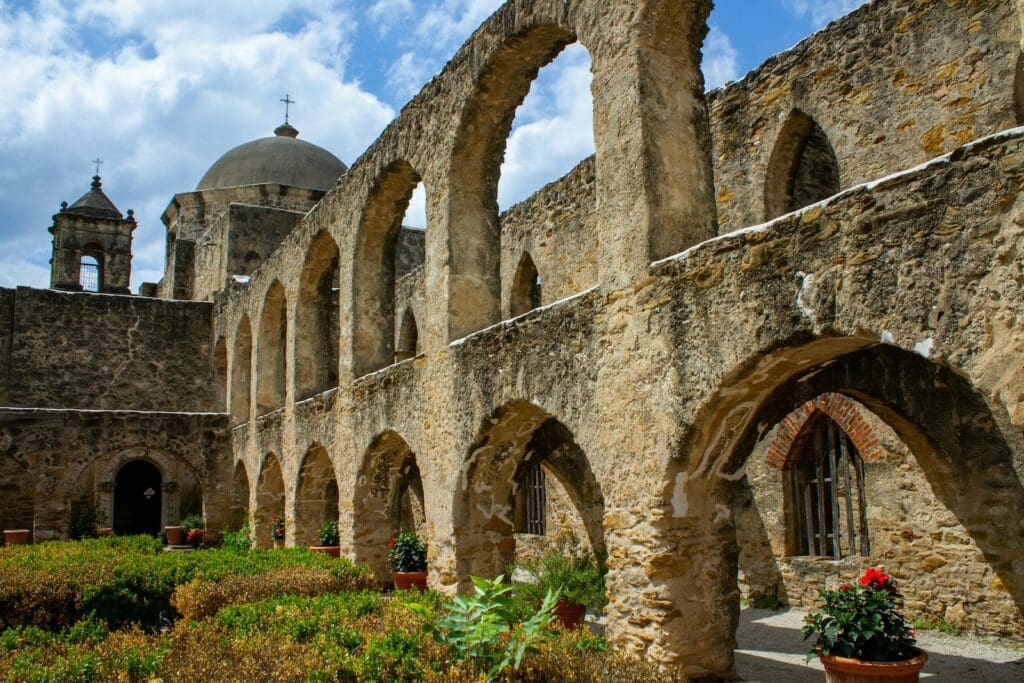
Nestled along the gently winding Riverwalk in San Antonio, Texas, a chain of historic missions stands as a testament to the region’s rich spiritual and cultural past. Established in the 18th century by Spanish Franciscan missionaries, these colonial outposts were more than just churches; they served as vital centers of community and agriculture, shaping the landscape of what would become modern San Antonio. Today, they invite visitors on a tranquil journey through history, offering a glimpse into the daily lives of their early inhabitants.
The San Antonio Missions National Historical Park encompasses four of these missions: Concepción, San José, San Juan, and Espada. Each mission showcases unique architectural features, from the intricate frescoes of Concepción to the impressive rose window at San José. These historical gems provide a backdrop for understanding the blending of Spanish and Indigenous cultures that occurred over centuries.
As they stroll along the river, visitors can absorb the serene atmosphere that still lingers in these ancient corridors and courtyards. The missions are still active parish churches, hosting regular services and continuing their legacy of faith. The journey through the San Antonio Missions is not just a physical path but a passage through time, offering a chance to reflect on the stories and spirituality that have shaped this corner of the world.
History of San Antonio Missions
The San Antonio Missions are a testament to the blend of cultures and the determination of early inhabitants to establish a foothold in the Texas frontier.
Early Beginnings of Mission Establishments
The story of San Antonio’s missions begins with Mission San Antonio de Valero, established in 1718. This mission, which would later be known as the Alamo, served as the first of five Spanish frontier missions constructed along the San Antonio River. These missions were designed to convert the local Native American population to Christianity and assimilate them into Spanish colonial society.
- 1718: Mission San Antonio de Valero (The Alamo) established.
- 1720: Mission San José founded.
- 1731: Missions San Juan, San Francisco de la Espada, and Santa Cruz de San Saba constructed.
Each mission consisted of a church, living quarters, workshops, and farms, thereby creating self-sufficient communities.
Struggles and Successes of the Missions
The missions faced numerous challenges, from resistance by indigenous people to diseases and frequent raids by Apache and Comanche tribes. Despite these struggles, the missions also saw significant successes.
Struggles:
- Resistance: Some indigenous people opposed the missionaries’ efforts to change their way of life.
- Diseases: European diseases drastically reduced the Native American population.
- Raids: Local tribes such as the Apache and Comanche conducted raids against the missions.
Successes:
- Agriculture: The missions became centers of agricultural production.
- Trade: They facilitated trade between different cultural groups.
- Cultural Exchange: The missions were points of cultural exchange between the Spanish and Native Americans, leading to a blend of traditions and practices.
By 1824, all of the missions were secularized, and their lands were distributed to the remaining Native American residents. These historical sites now tell the complex story of Texas’s early multicultural encounters.
Cultural Significance
The San Antonio Missions are not only reflective of a pivotal period in Texas history but also continue to influence local culture and identity.
Religious Impact on the Community
The chain of missions in San Antonio, primarily established by Spanish missionaries in the 18th century, deeply shaped the spiritual landscape of the region. They served as focal points for the spread of Catholicism, around which many communities grew. The San Antonio Missions include the famous Alamo (Mission San Antonio de Valero), as well as Missions San José, San Juan, Espada, and Concepción, dealing a significant impact on local customs and traditions. Today, these missions remain active parishes, with Mass and community events that perpetuate their religious functions.
Architectural Influence
The missions are prime examples of Spanish Colonial architecture, adapting traditional European church designs to the local materials and needs. Their structures were built with thick stone walls, carved wooden doors, and vaulted ceilings. Distinctive elements like bell towers and intricate façades have influenced local building styles. The use of local materials, such as limestone and adobe, set a precedent for sustainable architecture which is still relevant. They have inspired contemporary Texan architecture, blending the historical aesthetic with modern nuances.
The Riverwalk Experienc
The San Antonio Riverwalk offers visitors the unique opportunity to explore historical missions amidst vibrant natural scenery.
Journey Through the Missions
As they stroll along the Riverwalk, visitors encounter missions that are pillars of cultural history. Mission Concepción, with its well-preserved frescoes, tells the tale of Spanish colonization through its architectural grandeur. Just down the path, Mission San José, known as the “Queen of the Missions,” showcases intricate carvings on its iconic Rose Window.
- Mission San Juan captivates visitors with its sprawling farmlands, once vital for self-sustainability.
- At Mission Espada, the intricate acequia system (waterways) highlights early agricultural engineering in action.
Connecting with Nature
The Riverwalk meanders through diverse landscapes, offering a serene connection to nature. Visitors enjoy watching diverse bird species along the banks, indicative of the rich ecosystem. In addition, the presence of native plants and trees, such as the Texas live oak, adds an authentic touch to the surrounding historical sites.
Preservation Efforts
The protection and maintenance of the San Antonio Missions are critical to preserving this treasure trove of history for future generations.
Conservation of Historical Sites
The San Antonio Missions National Historical Park, in coordination with various organizations, undertakes meticulous preservation of the missions’ structures and grounds. Expert conservators focus on stabilizing deteriorating walls, restoring original frescos, and protecting artifacts against environmental damage. To retard decay, the use of traditional materials and techniques is favored, ensuring authenticity in restoration efforts.
Community Involvement
Local volunteers play a pivotal role in preservation activities, assisting with the regular upkeep of the mission grounds and gardens. Educational programs aim to foster a deep appreciation of the historical significance among residents, encouraging consistent community support. Notably, the annual “Restoration Day” event galvanizes public participation in conserving the missions, emphasizing their enduring cultural impact.
Visiting the Missions
The San Antonio Missions offer a unique blend of history and spirituality along the picturesque Riverwalk. Visitors can immerse themselves in the rich heritage of the area while enjoying a tranquil natural setting.
Planning Your Visit
Visitors are encouraged to start their journey at the Visitor Center to gather maps and information. The missions are open:
- Mission Concepción, San José, San Juan, Espada: Open daily from 9:00 AM – 5:00 PM.
- The Alamo: Monday – Sunday from 9:00 AM – 5:30 PM.
Admission to all missions is free, but donations are appreciated. Here is a suggestion for the order in which to visit the missions starting from the downtown area:
- The Alamo
- Mission Concepción
- Mission San José
- Mission San Juan
- Mission Espada
A convenient way to visit is following the Mission Reach, a section of the Riverwalk that links these historic sites.
Educational Opportunities
Each mission site serves as a living classroom. Interpretive tours and Ranger-led programs are available, providing insights into the Spanish colonial period. Key topics include:
- Spanish influence on local culture
- The role of missions in the community
- Indigenous peoples’ history
- Architectural features of the missions
Educational materials and programs are suitable for all ages, making a visit both informative and engaging.
Events and Activities
Throughout the year, the missions host a variety of events such as cultural festivals, outdoor concerts, and religious services, reflecting the ongoing community connection. Visitors should check the National Park Service website or the San Antonio Missions National Historical Park’s calendar for upcoming activities during their visit. Regular activities include:
- Yoga and wellness classes
- Artisan markets and craft fairs
- Volunteer opportunities to help maintain the site
Remember to plan ahead for any special events as they can affect visiting hours and parking availability.







